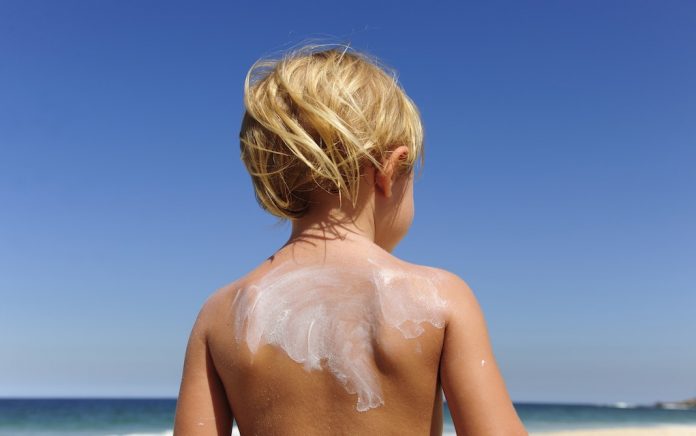
Sunburn damages the skin and places you at increased risk of skin cancer—so what can you do about it? Using effective mineral sunscreen is one answer, and that’s what we are going to talk about now. Specifically, we want to explain mineral sunscreen, which differs from the majority of chemical-based products on the market and offers some very important benefits to you and your family’s health.
What is Mineral Sunscreen?
If this is your first experience with mineral sunscreen, let’s do an introduction. Mineral sunscreen is a product that contains only the mineral active ingredients titanium dioxide and/or zinc oxide, which serve as physical barriers against ultraviolet A and B rays from the sun. Ultraviolet A rays can lead to premature aging and wrinkles, while B rays are the ones that redden your skin, but both can contribute to increased risk for skin cancers.
Read about 9 reasons to use 100% natural sunscreen
Mineral vs chemical sunscreen
Here are few things you should know about mineral vs chemical sunscreens:
- When you apply a mineral sunscreen, it sits on top of your skin and reflects UV rays away from your body with zinc and/or titanium.
- Chemical sunscreens, on the other hand, actually penetrate the skin and dissipate the rays as less harmful energy. Some of the chemicals can reach the bloodstream and even show up in breast milk. They also impact hormone levels in both men and women. In women, these chemicals have been linked to an increased risk of endometriosis and, in men, a decline in sperm concentration.
Do mineral sunscreens work right away?
Mineral sunscreens block both UVA and UVB rays away from the surface of the skin and work immediately after they are applied. Chemical sunscreens, on the other hand, must absorb into the skin, where they dissipate the harmful energy of UVA and UVB rays. This absorption requires a chemical reaction that can take 20 to 30 minutes, which means the chemical sunscreen is not completely effective during that time.
What are the ingredients in mineral sunscreen?
The primary ingredients are titanium and zinc, are very low on the toxicity scale and typically do not cause any allergies or skin reactions. However, substances such as oxybenzone and octinoxate, two very common chemical sunscreen actives, are associated with high toxicity ratings. According to the Environmental Working Group, sunscreens that contain oxybenzone and other chemicals (e.g., octinoxate, homosalate, octisalate, octocrylene, padimate O) are toxic because they penetrate the skin, where they can lead to skin allergies and disrupt endocrine functioning.
Is mineral sunscreen safe for babies?
Mineral sunscreens are safe for babies and are recommended by the American Academy of Pediatrics, while chemical products are not. One word of caution, however, is to look for sunscreen products that claim to be mineral-based but may also contain chemicals. Be sure to always read the label and ingredient list on any sunscreen product you buy for your baby or yourself, and make sure only zinc or titanium are the active/medicinal ingredients.
How to use mineral sunscreen
Mineral sunscreens are different from chemical products, so you may need to use different application methods to reap the best results.
- Moisturize your skin. Mineral sunscreens should ideally be applied to hydrated skin to avoid a whitening effect from the mineral content or uneven application. Prime your skin with body moisturizer or body oil, both of which will absorb rather quickly. Choose your favorite body oil or moisturizer and rub it in thoroughly. Well-hydrated skin allows the minerals to spread more evenly for a sheer application and consistent protection against skin damage associated with sun exposure. We recommend a product that contains antioxidants, which, along with the sunscreen, will help protect your skin against damage from ultraviolet rays.
- Apply a little at a time. If you put on too much mineral sunscreen at one time, you may end up with a white, pasty look and uneven coverage. Instead, start with a small amount and rub the sunscreen onto your skin in long strokes.
- Move fast. Just as you want to start with a small amount of lotion, you also want to focus on one small area at a time. The minerals need to be applied smoothly and evenly to provide sheer, consistent coverage, but if the lotion soaks in before you have a chance to move it around, you might end up with a thick layer of minerals in one area and not enough coverage in others.
- Test on a small area. If you have extra-sensitive skin, doing a patch test before using a product on your whole body is always a good idea. Dispense a small amount of mineral sunscreen into your palm, spread it evenly over a limited test area, and check for any skin reactions. Depending on your level of sensitivity, you may want to wait a few hours, but typically if you don’t see any adverse reaction after a few minutes, you should be ready to use the sunscreen.
Sources
American Academy of Pediatrics. Sun Safety and Protection Tips from the American Academy of Pediatrics.
Buck LGM et al. Urinary concentrations of benzophenone-type ultraviolet light filters and semen quality. Fertility & Sterility 2015 Oct 104(4): 989-96
Environmental Working Group. The trouble with ingredients in sunscreen.
Kunisue T et al. Urinary concentrations of benzophenone-type UV filters in US women and their association with endometriosis. Environmental Science and Technology 2012 Apr 17; 46(8): 4624-32










